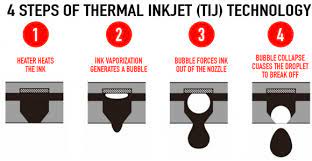What is Inkjet Printing Technology?
Inkjet printing technology is a type of computer printing technology that uses droplets of ink to recreate a digital image on paper and plastic substrates. Inkjet printers were the most popular type of printer in 2008, and they range from low-cost consumer models to high-end professional machines. Laser printers outsold inkjet printers by nearly a 2:1 margin in 2019, 9.6% vs 5.1%.
Inkjet printing technology originated in the twentieth century, and the technology was first widely developed in the early 1950s. Ichiro Endo proposed the idea for a "Bubble jet" printer while working at Canon in Japan, and around the same time, Jon Vaught at HP was developing a similar idea. Inkjet printers capable of reproducing digital images generated by computers were developed in the late 1970s, primarily by Epson, Hewlett-Packard (HP), and Canon. Canon, HP, Epson, and Brother account for the vast majority of inkjet printer sales in the global consumer market.
In 1982, Robert Howard had the idea to create a small color printing technology that used piezos to spit ink drops. He founded R.H. (Robert Howard) Research (renamed Howtek, Inc. in February 1984) and created the groundbreaking technology that resulted in the Pixelmaster color printer with solid ink using Thermojet technology. This technology consists of a tubular single nozzle acoustical wave drop generator invented in 1972 with a glass nozzle and improved in 1984 with a Tefzel molded nozzle by a Howtek inkjet engineer to remove unwanted fluid frequencies.
Inkjet technologies, typically printheads with piezoelectric crystals, are used in the emerging ink jet material deposition market to deposit materials directly on substrates.
The technology has advanced, and the 'ink' can now include solder paste in PCB assembly or living cells for the creation of biosensors and tissue engineering.
Inkjet printer images are sometimes sold under brand names such as Digigraph, Iris prints, giclée, and Cromalin.
To imply a higher quality product and avoid association with everyday printing, inkjet-printed fine art reproductions are commonly sold under such trade names.
Depending on the quality of the inks and paper used, inkjet documents can range from poor to excellent in terms of archival durability. Because of the residual acid in the untreated pulp, low-quality paper can yellow and degrade; in the worst case, old prints can literally crumble into small particles when handled. On acid-free paper, high-quality inkjet prints can last as long as typewritten or handwritten documents.
Because the ink used in many low-cost consumer inkjets is water-soluble, inkjet-printed documents must be handled with care to avoid even the smallest drop of moisture, which can cause severe "blurring" or "running." Even sweaty fingertips during hot, humid weather can cause low-quality inks to smear. Water-based highlighter markers, on the other hand, can blur inkjet-printed documents and discolor the highlighter's tip. The lifetime of inkjet prints produced with aqueous inks is generally shorter (although UV-resistant inks are available) than that of inkjet prints produced with solvent-based inkjets; however, so-called "archival inks" for use in aqueous-based machines have been developed, which offer extended life.
Many inks fade gradually over time, which can be a problem. Print longevity is highly dependent on ink quality and formulation. Dye-based inks were used in the first inkjet printers, which were intended for home and small office use. Dye-based inks aren't as long-lasting as pigment-based inks, which are now available for a wide range of inkjet printers. Inkjet printers now use pigment-based inks that are extremely water resistant: black ink is frequently pigment-based. Resin or silicone protected photopaper is widely available and reasonably priced, providing complete water and mechanical rub resistance for dye and pigment inks. Because pigment particles are too large to pass through the dye-only photopaper protection layer, the photopaper itself must be designed for pigment or dye inks.



